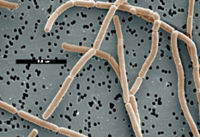Lactobacillus delbrueckii
| Lactobacillus delbrueckii | ||||||||||||||
|---|---|---|---|---|---|---|---|---|---|---|---|---|---|---|
 | ||||||||||||||
| Scientific classification | ||||||||||||||
|
Description and significance
L. delbrueckii is a Gram-positive bacteria and a facultative anaerobe. It is long, filamentous and non-motile with its cell size ranging between 0.5- 0.8 by 2.0-9.0 millimeters. The environment in which L. delbrueckii thrives the most would be one of relatively low pH, preferring acidic environments making them acid tolerant. L. delbrueckii undergoes obligate homofermtentative metabolism which means it is only able to ferment lactose and no other sugar. L. delbrueckii is found in dairy products such as yogurt, milk, and cheese.
In 1905, Stamen Grigoroy, a Bulgarian doctor, discovered L. delbrueckii subspecies bulgaricus to be a true cause for the existence of natural yogurt. This was an important discovery since it led to further discovery of probiotic effects on humans and animals which improves lactose tolerance and has the ability to stimulate immune responses.
That strain of bacillus was L. delbrueckii subsp. Bulgaricus. A recent study reported the isolation and characterization of L. delbrueckii subsp. bulgaricus along with its symbiont Streptococcus thermophilus from plants in Bulgaria were the basis of tradional yogurt preparation.
Genome structure
Lactobacillus delbrueckii subspecies bulgaricus has a circular genome ATCC 11842 that is made up of 1,864,998 nucleotides. It has a GC content of 49% and has 2,217 genes. Of the 2,217 genes 1,562 code for proteins such as prtB and the lac operon. These proteins contribute to the homofermentative properties observed in L. delbrueckii. The genes that are encoded to take up and break down lactose are the lacS, lacZ, and lac R genes located within the lac operon. Transport of lactose through the membrane is the primary responisibility of lactose permease that is coded by the lacS gene. On the other hand, the lacZ gene, encodes the enzyme B-galactosidase need to metabolize lactose.
Cell structure and metabolism
L. delbrueckii is a Gram-positive bacteria. For it to retain the purple stain from the Gram test, L. delbruekii has a large amount of peptidoglycann in its cell walls. In addition, it is sensitive to bacteriophage attack; this may be due to the fact that it has no outer membrane.
The prtB gene encodes proteases which is found anchored along the cell wall of subspecies L. delbrueckii bulgaricus and L. delbrueckii lactis. Enzymatic activity that takes place in the casein allows these subspecies to grow in dairy products. The enzymatic activity allow exposure of essential amino acids and allow constitutive or inducible expression of the lacZ gene. L. delbrueckii bulgaricus and L. delbrueckii indicus can metabolize fructose, glucose, lactose, and mannose. L. delbrueckii lactis catabolizes galactose, maltose, sucrose, trehalose and other modified carbohydrates.
Ecology
L. delbrueckii bulgaricus, a subspecie of Lactobacillus delbrueckii is found to have a symbiotic relationship with Streptococcus thermophilus. Together they coexist in starter lactic acid bacteria cultures. The lactic acid that is produced also contributes in preserving milk and is often helpful to sufferers of lactose intolerance, whose digestive systems lack the enzymes to break down lactose to simpler sugars.. L. delbrueckii are also symbiotic with the gastrointestinal tract and vagina of humans.
L. delbrueckii subsp. bulgaricus is a component of thermophillic starter cultures used to manufacture a number of fermented dairy products. These cultures contain Streptococcus thermophilus with L. delbrueckii subsp. bulgaricus and are utilized in yogurt, Swiss-type and Italian-type cheese varieties.
There has been a significant increase in the past twenty years in the production of both Mozzarella cheese and yogurt in the United States of America. According to USDA statistics, in 1980, 688,000,000 pounds of Mozzarella cheese were produced in the U.S. By 1998, Mozzarella production had increased 325%, to more than 2,244,000,000 pounds, with an economic value of nearly $1 billion.
Yogurt production has seen a similar increase, from 570,000,000 pounds in 1980 to 1,371,000,000 pounds in 1997, a 240% increase. The wholesale value of yogurt in 1997 was over $1.1 billion. L. delbrueckii subsp. bulgaricus is utilized in the manufacture of products in the United States of America with a value of more than $2.1 billion.
Pathology
L. delbrueckii is non-pathogenic. Research has been carried out by many institutes worldwide that have proved that Bulgarian yogurt helps in the treatment of various diseases and conditions like infections, tuberculosis, stomach and intestine conditions, ulcers, and many other diseases.
Application to Biotechnology
Two subspecies of Lactobacillus delbrueckii, L. delbrueckii bulgaricus and L. delbrueckii lactis play a major role in the dairy industry. Fermented yogurt, milk, and cheese are cultured from these two subspecies. If the process of fermentation that occurs through L. delbrueckii bulgaricus and L. delbrueckii lactis came to a halt it would result in a large economic loss. This is why care must be taken to keep the conditions of production constant.
Current Research
Mitogenic effects have been found in specific strains of Lactobacilli. Thes strains have also been found to aid in spleen cell proliferation. YS strains, of L. delbrueckii bulgaricus and L. acidophilus, when heated induce a generation of IgM and IgG by murine spenocytes and was dependent on bacterium concentrations. ELISA and the Fisher's test allowed for the determination of antibody concentrations. In addition, strains YS of the two strains induced lymphocyte proliferation. L. delbrueckii bulgaricus was shown to activate polyclonal B-cells indicated from the maintenance of high antibody levels upon removal of Lactobacilli antibodies.
Lactobacillus delbrueckii are usually not found outside starter cultures in dairy products. Six hundred sixty five plant samples, with the target plant Cornus mas were collected from four sites away from human habitation. Identification of the L. delbrueckii bulgaricus was determined via phenotype analysis, Pulse field gel electrophoresis (PFGE) analysis, and PCR methods. The cultures samples that grew at 45°C were rod shaped, produced D-lactate, generated a DNA fragment of 1065 base pairs with the primers LB1/LLB1, and showed proteolytic activity.